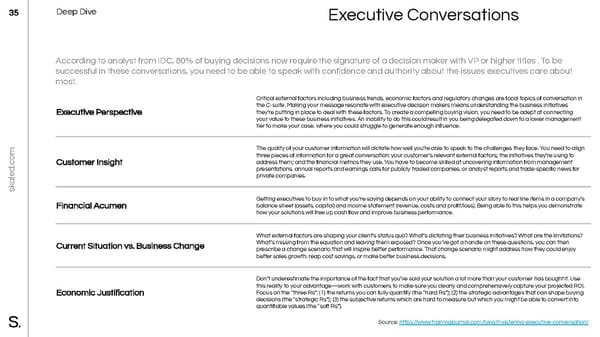Deep Dive 35 Executive Conversations According to analyst from IDC, 80% of buying decisions now require the signature of a decision maker with VP or higher titles . To be successful in these conversations, you need to be able to speak with confidence and authority about the issues executives care about most. Critical external factors including business trends, economic factors and regulatory changes are focal topics of conversation in the C-suite. Making your message resonate with executive decision makers means understanding the business initiatives they’re putting in place to deal with these factors. To create a compelling buying vision, you need to be adept at connecting Executive Perspective your value to these business initiatives. An inability to do this could result in you being delegated down to a lower management tier to make your case, where you could struggle to generate enough influence. The quality of your customer information will dictate how well you’re able to speak to the challenges they face. You need to align three pieces of information for a great conversation: your customer’s relevant external factors; the initiatives they’re using to address them; and the financial metrics they use. You have to become skilled at uncovering information from management Customer Insight presentations, annual reports and earnings calls for publicly traded companies, or analyst reports and trade-specific news for private companies. aled.com sk Getting executives to buy in to what you’re saying depends on your ability to connect your story to real line items in a company’s balance sheet (assets, capital) and income statement (revenue, costs and profit/loss). Being able to this helps you demonstrate Financial Acumen how your solutions will free up cash flow and improve business performance. What external factors are shaping your client’s status quo? What’s dictating their business initiatives? What are the limitations? What’s missing from the equation and leaving them exposed? Once you’ve got a handle on these questions, you can then Current Situation vs. Business Change prescribe a change scenario that will inspire better performance. That change scenario might address how they could enjoy better sales growth, reap cost savings, or make better business decisions. Don’t underestimate the importance of the fact that you’ve sold your solution a lot more than your customer has bought it. Use this reality to your advantage—work with customers to make sure you clearly and comprehensively capture your projected ROI. Focus on the “three Rs”: (1) the returns you can fully quantify (the “hard Rs”); (2) the strategic advantages that can shape buying Economic Justification decisions (the “strategic Rs”); (3) the subjective returns which are hard to measure but which you might be able to convert into quantifiable values (the “soft Rs”). Source: https://www.trainingjournal.com/blog/mastering-executive-conversation/
 Webinar Presentation: Engagement in Zoom World Page 34 Page 36
Webinar Presentation: Engagement in Zoom World Page 34 Page 36